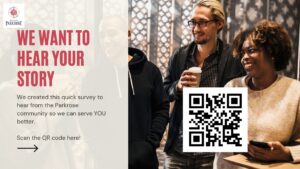Parkrose Community Plan
Working together on a plan for the future of Parkrose
The greater Parkrose neighborhood is a diverse part of Portland, with a high population of communities of color. There are many community assets in Parkrose, including a thriving school district and local organizations and businesses.
Some community concerns in the area include rising rents, the need for more living-wage jobs for students and their parents, unsafe conditions on Sandy Boulevard, the need for community gathering places, and a disaster-preparedness plan for marginalized communities.
These long-standing issues impact historically marginalized groups the most. With the support of the Portland Bureau of Planning and Sustainability and the Oregon Department of Transportation, the Historic Parkrose NPI finalized the Parkrose Community Plan in 2021 with underserved groups to address these community concerns.
Process for Developing the Parkrose Community Plan
During 2020, members of the Parkrose community met in a series of virtual workshops, community working group meetings, open house sessions and surveys to create the Draft Parkrose Community Plan. This Draft was further reviewed at two Open Houses to finalize proposed actions for the following key issues confronting Parkrose:
- Address affordable housing needs
- Connect youth to job opportunities
- Support home-based businesses and other small businesses
- Create new pedestrian crossings on Sandy Boulevard and safe connections to schools and other community destinations
- Provide more community gathering places and connections to nature
- Connect the community to resources to be better prepared for emergencies
The final Parkrose Community Plan, Parkrose Community Plan Summary, and other related documents reside on the City of Portland BPS website. You can read these documents by clicking here.
Some Facts
The Parkrose area has historically mirrored East Portland demographics, with a population that is more diverse, has more families, and is less wealthy than the city as a whole. With major shifts citywide from a working-class to middle-class city, Parkrose is increasingly following citywide trends. Around 2015, families in the Parkrose School District started getting displaced from the area. Similarly, based on 2010 to 2019 census data, the population of communities of color fell from 43 percent to 35 percent of the area’s population, with a 36 percent drop in the numbers of children and youth in the area.
As lower-income families have been uprooted from the neighborhood, there’s also been an increase in homeowners versus renters. Parkrose home prices have increased faster over the past 10 years than the city as a whole, with the median single-family home price in the area rising 68 percent between 2010 and 2020 (compared to a 56 percent increase citywide). As housing costs are usually the highest household budget item, overall city rent increases impact working poor communities, which most impact historically marginalized communities of color.
Parkrose Community Plan draft existing conditions reports (Transportation, Demographics, Housing, Jobs/Businesses)
- PCP Existing Conditions info
- Parkrose Demographics Report (260.46 Kb) Summary of demographic information for the Parkrose Community Plan study area.
- Parkrose Existing Transportation Conditions (8.81 Mb)Summary of existing transportation conditions in the Parkrose Community Plan area.
- Parkrose Housing Existing Conditions Report (4.45 Mb) Summary of existing housing and related demographic information for the Parkrose Community Plan study area.
- Parkrose Workforce & Small Business Existing Conditions Report (1.24 Mb) Summary of jobs and businesses information for the Parkrose Community Plan study area.

